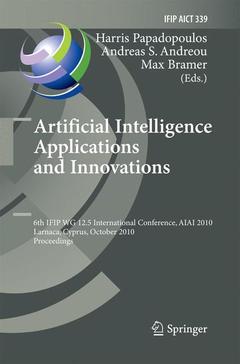Description
Artificial Intelligence Applications and Innovations, 2010
6th IFIP WG 12.5 International Conference, AIAI 2010, Larnaca, Cyprus, October 6-7, 2010, Proceedings
IFIP Advances in Information and Communication Technology Series, Vol. 339
Coordinators: Papadopoulos Harris, Andreou Andreas S., Bramer Max
Language: English
Subjects for Artificial Intelligence Applications and Innovations:
Artificial Intelligence Applications and Innovations
Publication date: 11-2014
404 p. · 15.5x23.5 cm · Paperback
Publication date: 11-2014
404 p. · 15.5x23.5 cm · Paperback
Artificial intelligence applications and innovations: 6th ifip wg 12 5 international conference, aiai 2010, larnaca, cyprus, october 6-7, 2010,
Publication date: 09-2010
404 p. · 15.5x23.5 cm · Hardback
Publication date: 09-2010
404 p. · 15.5x23.5 cm · Hardback
Description
/li>Contents
/li>Comment
/li>
The abundance of information and increase in computing power currently enable researchers to tackle highly complicated and challenging computational problems. Solutions to such problems are now feasible using advances and innovations from the area of Artificial Intelligence. The general focus of the AIAI conference is to provide insights on how Artificial Intelligence may be applied in real-world situations and serve the study, analysis and modeling of theoretical and practical issues. This volume contains papers selected for presentation at the 6th IFIP Conference on Artificial Intelligence Applications and Innovations (AIAI 2010) and held in Larnaca, Cyprus, during October 6?7, 2010. IFIP AIAI 2010 was co-organized by the University of Cyprus and the Cyprus University of Technology and was sponsored by the Cyprus University of Technology, Frederick University and the Cyprus Tourism Organization. AIAI 2010 is the official conference of the WG12.5 ?Artificial Intel- gence Applications? working group of IFIP TC12, the International Federation for Information Processing Technical Committee on Artificial Intelligence (AI). AIAI is a conference that grows in significance every year attracting researchers from different countries around the globe. It maintains high quality, standards and welcomes research papers describing technical advances and engineering and ind- trial applications of intelligent systems. AIAI 2010 was not confined to introducing how AI may be applied in real-life situations, but also included innovative methods, techniques, tools and ideas of AI expressed at the algorithmic or systemic level.
Invited Talks.- How Artificial Intelligence May Be Applied in Real World Situations.- Modern Machine Learning Techniques and Their Applications to Medical Diagnostics.- Innovative Applications of Artificial Intelligence Techniques in Software Engineering.- Machine Learning.- Linear Probability Forecasting.- The Importance of Similarity Metrics for Representative Users Identification in Recommender Systems.- An Optimal Scaling Approach to Collaborative Filtering Using Categorical Principal Component Analysis and Neighborhood Formation.- A Classroom Observation Model Fitted to Stochastic and Probabilistic Decision Systems.- Prediction with Confidence Based on a Random Forest Classifier.- Fuzzy Logic Techniques.- A Generic Tool for Building Fuzzy Cognitive Map Systems.- A Fuzzy Rule-Based Approach to Design Game Rules in a Mission Planning and Evaluation System.- One-Dimensional Linear Local Prototypes for Effective Selection of Neuro-Fuzzy Sugeno Model Initial Structure.- Lasso: Linkage Analysis of Serious Sexual Offences.- Evolutionary Computation.- Forecasting Euro – United States Dollar Exchange Rate with Gene Expression Programming.- Automatically Designing Robot Controllers and Sensor Morphology with Genetic Programming.- Multiple Criteria Performance Analysis of Non-dominated Sets Obtained by Multi-objective Evolutionary Algorithms for Optimisation.- Efficiency and Robustness of Three Metaheuristics in the Framework of Structural Optimization.- Medical Informatics and Biomedical Engineering.- A Fuzzy Non-linear Similarity Measure for Case-Based Reasoning Systems for Radiotherapy Treatment Planning.- A Soft Computing Approach for Osteoporosis Risk Factor Estimation.- Protein Secondary Structure Prediction with Bidirectional Recurrent Neural Nets: Can Weight Updating for Each Residue Enhance Performance?.- Contourlet Transform for Texture Representation of Ultrasound Thyroid Images.- Assessment of Stroke Risk Based on Morphological Ultrasound Image Analysis with Conformal Prediction.- Text Mining and Natural Language Processing.- Concept Based Representations as Complement of Bag of Words in Information Retrieval.- Information Fusion for Entity Matching in Unstructured Data.- An Example-Tracing Tutor for Teaching NL to FOL Conversion.- Learning the Preferences of News Readers with SVM and Lasso Ranking.- Knowledge Representation and Reasoning.- A Comparison of Two Ontology-Based Semantic Annotation Frameworks.- A Tool for Automatic Creation of Rule-Based Expert Systems with CFs.- Non-standard Reasoning Services for the Verification of DAML+OIL Ontologies.- Algorithms for the Reconciliation of Ontologies in Open Environments.- Knowledge-Based Support for Software Engineering.- Planning and Scheduling.- A Hybrid Searching Method for the Unrelated Parallel Machine Scheduling Problem.- Aiding Interactive Configuration and Planning: A Constraint and Evolutionary Approach.- Decentralized Services Orchestration Using Intelligent Mobile Agents with Deadline Restrictions.- Mobile Robot-Assisted Cellular Environment Coverage.- Feature Selection and Dimensionality Reduction.- A Novel Feature Selection Method for Fault Diagnosis.- Dimensionality Reduction for Distance Based Video Clustering.- Towards Stock Market Data Mining Using Enriched Random Forests from Textual Resources and Technical Indicators.- On the Problem of Attribute Selection for Software Cost Estimation: Input Backward Elimination Using Artificial Neural Networks.- Engineering Intelligent Systems.- A Fast Mobile Face Recognition System for Android OS Based on Eigenfaces Decomposition.- Application of Conformal Predictors to Tea Classification Based on Electronic Nose.- Detecting and Confining Sybil Attack in Wireless Sensor Networks Based on Reputation Systems Coupled with Self-organizing Maps.- Statistical Fault Localization with Reduced Program Runs.- Fuzzy Cognitive Map for Software Testing Using Artificial Intelligence Techniques.- Intelligent User Environments and HCI.- Learning User Preferences in Ubiquitous Systems: A User Study and a Reinforcement Learning Approach.- Decision Oriented Programming in HCI: The Multi-Attribute Decision Language MADL.- Investigating the Role of Mutual Cognitive Environment for End-User Programming.- On the Quantification of Aging Effects on Biometric Features.- Environmental Modeling.- Fuzzy Inference Systems for Automatic Classification of Earthquake Damages.- A Fuzzy Inference System Using Gaussian Distribution Curves for Forest Fire Risk Estimation.- Evolutionary Prediction of Total Electron Content over Cyprus.- A Multi-layer Perceptron Neural Network to Predict Air Quality through Indicators of Life Quality and Welfare.
State-of-the-art research
Fast-track conference proceedings
Unique visibility
© 2024 LAVOISIER S.A.S.




